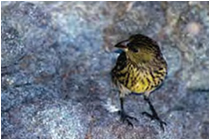Terrestrial Endemism in Papahānaumokuākea Marine National Monument
 The terrestrial area of Papahānaumokuākea is comparatively small, but it is a critically important component of the ecosystem. More than 14 million seabirds nest, rest and breed on the tiny islets in the chain, including 99% of the world’s Laysan Albatrosses (listed as vulnerable by IUCN) and 98% of the world’s Black-footed Albatrosses (listed as endangered by IUCN). The extinct Laysan Honeycreeper, and the extant Nihoa Finch and Laysan Finch, are all members of the family Drepanididae, the Hawaiian honeycreepers, a family that underwent one of the world’s most spectacular avian radiations from a single ancestral species. This remarkable proliferation of species from a single ancestral type is often compared to the evolutionary radiation of Darwin’s finches on the Galapagos Islands. Representatives in many other taxa of plants and animals that have undergone similar radiations also occur in Papahānaumokuākea. The endangered fan palm, Pritchardia remota, found only on Nihoa, is most closely related to three endangered Pritchardia species found in remote areas of the main Hawaiian Islands. The entomofauna of Papahānaumokuākea also includes some groups of insects that demonstrate dramatic adaptive radiations. One such group is the seed bugs, specifically the genus Nysius, which shows the complete range of feeding types: from host-specific plant feeders, to diverse plant hosts, to omnivorous feeding, and finally to predator/scavengers. It is a rare occurrence to find herbivorous and carnivorous seed bugs within the same genus. Nowhere else in the world is there a lineage like the Hawaiian Nysius, which exemplifies evolution of carnivory in Heteroptera. The terrestrial and marine habitats of Papahānaumokuākea are crucial for the survival of many threatened species, several of which are found on only one island, or have limited ranges. Some of these species are of particular conservation concern because of their limited ranges. IUCN recently named the unprotected Emperor Seamounts, the northernmost part of the Hawaiian-Emperor Archipelago, as first on its list of “High Seas Gems” - “areas of concentrated abundance or diversity, rarity, naturalness, or vulnerability.” Papahānaumokuākea, the protected neighboring section of this archipelago, shares these qualities.
The terrestrial area of Papahānaumokuākea is comparatively small, but it is a critically important component of the ecosystem. More than 14 million seabirds nest, rest and breed on the tiny islets in the chain, including 99% of the world’s Laysan Albatrosses (listed as vulnerable by IUCN) and 98% of the world’s Black-footed Albatrosses (listed as endangered by IUCN). The extinct Laysan Honeycreeper, and the extant Nihoa Finch and Laysan Finch, are all members of the family Drepanididae, the Hawaiian honeycreepers, a family that underwent one of the world’s most spectacular avian radiations from a single ancestral species. This remarkable proliferation of species from a single ancestral type is often compared to the evolutionary radiation of Darwin’s finches on the Galapagos Islands. Representatives in many other taxa of plants and animals that have undergone similar radiations also occur in Papahānaumokuākea. The endangered fan palm, Pritchardia remota, found only on Nihoa, is most closely related to three endangered Pritchardia species found in remote areas of the main Hawaiian Islands. The entomofauna of Papahānaumokuākea also includes some groups of insects that demonstrate dramatic adaptive radiations. One such group is the seed bugs, specifically the genus Nysius, which shows the complete range of feeding types: from host-specific plant feeders, to diverse plant hosts, to omnivorous feeding, and finally to predator/scavengers. It is a rare occurrence to find herbivorous and carnivorous seed bugs within the same genus. Nowhere else in the world is there a lineage like the Hawaiian Nysius, which exemplifies evolution of carnivory in Heteroptera. The terrestrial and marine habitats of Papahānaumokuākea are crucial for the survival of many threatened species, several of which are found on only one island, or have limited ranges. Some of these species are of particular conservation concern because of their limited ranges. IUCN recently named the unprotected Emperor Seamounts, the northernmost part of the Hawaiian-Emperor Archipelago, as first on its list of “High Seas Gems” - “areas of concentrated abundance or diversity, rarity, naturalness, or vulnerability.” Papahānaumokuākea, the protected neighboring section of this archipelago, shares these qualities.
